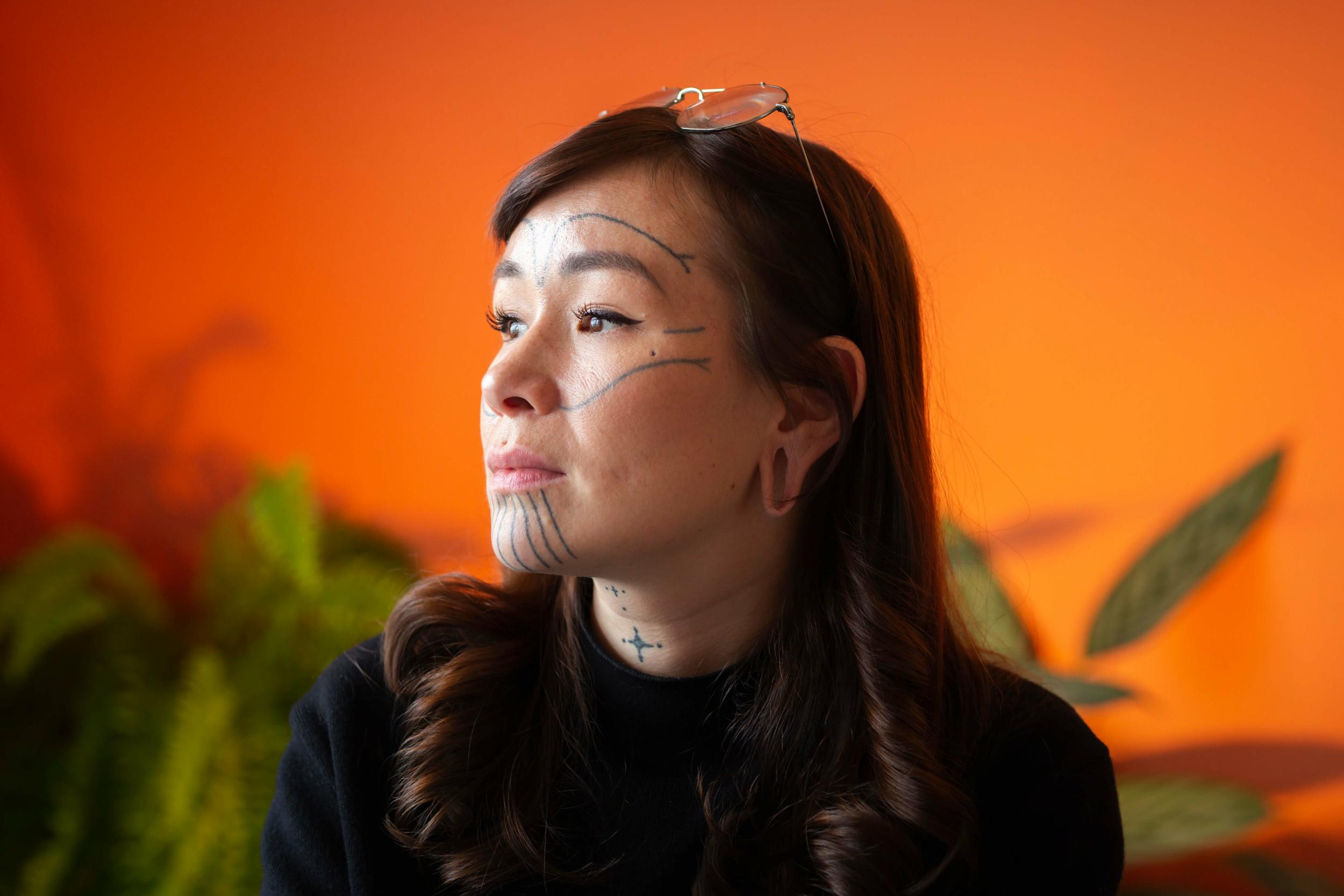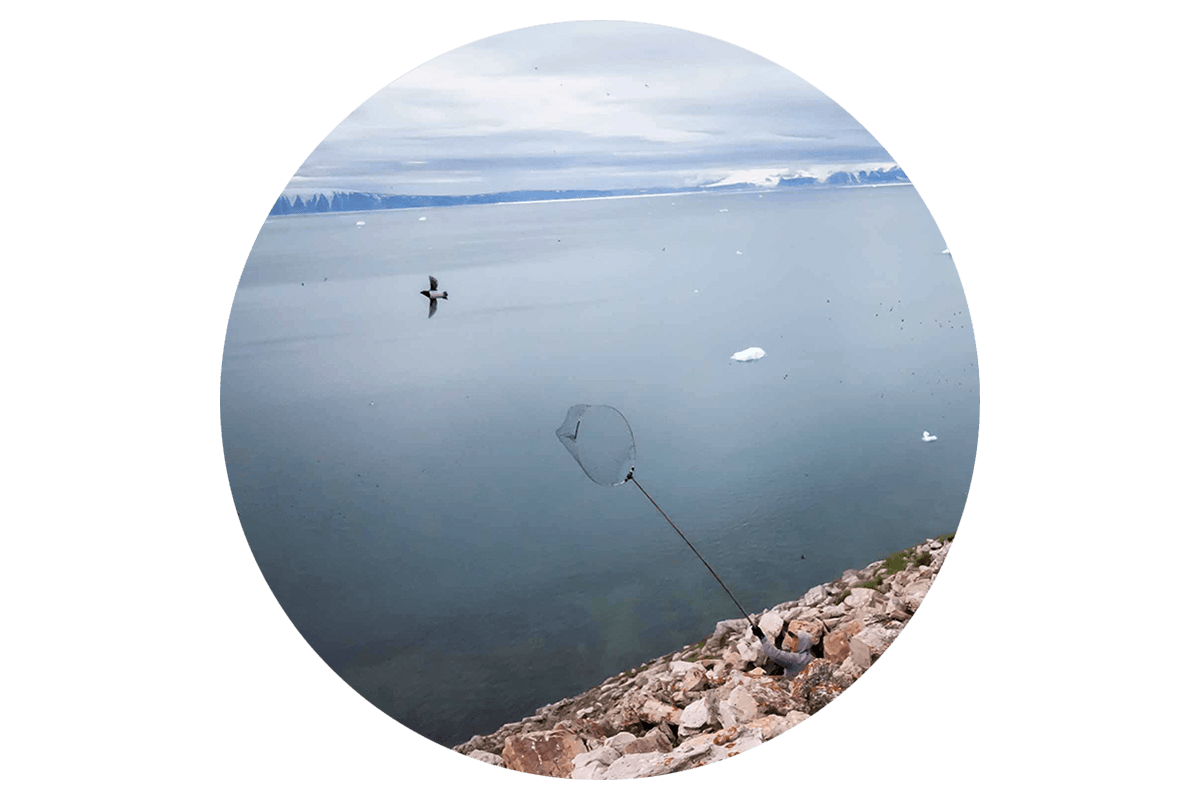Who are the Inuit?
Inuit are the people living in the Arctic region of the North American continent – the areas we know today as Alaska, Canada and Greenland. The Inuit culture and way of life, based on hunting, has evolved and adapted to the Arctic environment and the animals that live in the areas.
For the Inuit, the ‘sacred’, spiritual and religious are everything that surrounds us, and, in that worldview, everything is animate and alive, i.e., all vegetation, animals and soil. All these elements that surround us and have adapted to the Arctic environment have a strength and an attribute that we borrowed from when we had to protect ourselves from the harsh conditions we lived under, and these elements helped shape our use of amulets and Tunniit.
Tattoos, Kakiornerit or Tunniit?
The process and method are colloquially called Kakiorneq in West Greenland and Kagierneq in East Greenland. Kakiorneq/Kagierneq translates as inserted or underlined with a needle in English.
The English word Tattoo (tattow) that the English explorer James Cook mistakenly paraphrased from the Polynesian word Ta tatau, which is the people’s description of how their tattoos are done. As this term originates from a different culture and language, with a body-tattoo tradition with its own intentions, and as Inuit have their own word and concept for theirs, it is a wish to respect that they are called by their original name, Tunniit. Tunniit is the plural of Tunneq, where something has landed, as they are called, because of how a single stitch, Kakiorneq, looks in the skin, and when many are put in a row and form patterns, Tunniit.
Did you know?
Tunniit: Past and present
In 1972, 8 mummies were found at an ancient settlement, Qilakitsoq, near Uummannaq. They have been dated to have lived around 1475 AD, and of the 8 mummies, there were 6 women and 2 children, with 5 of the women having Tunniits. Throughout the Arctic, Tunniit is an extension of women’s collective spiritual responsibility and skills in sewing. This also means that it was mainly women who practised and had them. Therefore, it is a mystery why the youngest woman from Qilakitsoq, who is about 20 years old, did not have them. Traditions may be dispensed with in particular and rare cases or become “customised” to the circumstances, but we can only theorise about the reasons in this case. The mummies are exhibited in the National Museum of Greenland in Nuuk.
Kakiorneq methods
The most common method was to use women’s sewing needles and sinew threads, which were dipped in a mixture of soot, oil and urine and pulled through the outer layers of skin. It left small lines under the skin, forming the amulet patterns in dense rows that women had on their bodies. In some places, they were also done by using a sharp tool to poke a small hole in the skin, where you then poke again with a sooty tool, which left a small dot. The women from Qilakitsoq’s Tunniits show evidence that both methods had been used.
Most important tattoos for women
The Inuit’s most important tattoos are those worn on the face and hands. A woman’s first Tunniit is the Talloqut, the chin tattoo she receives when her skills are good enough for her to help fill a role and take on responsibilities in her community. It usually happens around the age of her first menstruation. However, certain circumstances might make it necessary for girls to grow up quickly. If, on the other hand, it was a time of plenty and with many women to shoulder the collective spiritual responsibility, then girls could remain girls for longer.
The shape of the facial tattoos indicates to which group of Inuit one belongs, and they, therefore, vary in appearance among all Inuit groups. The forehead and cheeks, in particular, are group tattoos.
The patterns had an amuletic intention, which was associated with a practice or with tools.
One of the most important inventions in our culture, sinew threads, made it possible to sew garments, qaannat (kayaks) and Umiat (women’s boats). It’s like the invention that stitched our whole existence together, and it also tells you how important it was to be well supplied with them. This is also evident in women’s Tunniit, where sinew thread amulets are strongly represented both as single amulets and in combination with other patterns.
The winter lasts for 8 months in the Arctic, and there are several months of winter darkness in the northernmost regions. The flame of the soapstone lamp is the only source of light and heat and the possibility of hot food. So, with a wish that the flame should not go out, the women also carried the flame as an amulet.
Although the hunters had developed an amazing skill in hunting, through many generations of knowledge of the animals and methods, it also took some luck. So, the woman had lines on her fingers to honour Takannaaluk, whose fingers the sea creatures came from, and whale tails to invoke whales to ensure that the animals were always near their fishing grounds.
The amulet patterns on the back of hands and arms were meant to provide the community with resources for survival. While the amulets on legs were to ensure future children. At the same time, the first thing that a child saw at birth was something beautiful.
Although it is mainly women who both practised and had Tunniit, men also had some tattoos made for whaling or tattoos to cleanse them from an incident or to make amends if they had harpooned an animal that got away where they could not perform the traditions to help the soul of the animal to the right place.
The Disappearance and revival Of Tunniit
The arrival of missionaries has changed the religion and worldview of all Inuit. In Greenland, this happened when the missionaries arrived in 1721. In less than 50 years, the use of Tunniit gradually disappeared on the West Greenland coast. However, East Greenlandic Inuit, first colonised in 1894, practised Tunniit until the early 1900s, bringing Tunniit with them when a group migrated south.
In other Inuit areas such as Nunavut (Canada) and Alaska, as well as Siberia, colonisation took place later, and through living memories of Tunniit, they began to practice it again in the early 2000s. In collaboration with the Inuit of Alaska, Tunniit was reintroduced to Greenland in 2017. In the last few years, many now have Tunniit again, breathing new life into the practice. Although Tunniit dates from a time when the Inuit relied on hunting and had a spirituality based on everything being animated, many Inuit use them in the same tradition today. They have them on behalf of their loved ones and to show and honour the connection to their culture and ancestors.
Although many have Tunniit again, the revival of this practice is still very new and vulnerable because many have not relearned their use and intention. Many may find it a sensitive subject when people who are not Inuit ask about them. Not everyone is comfortable sharing information about them, as most also have them for very personal reasons and out of our human and spiritual values as indigenous people.
MAY I OR MAY I NOT
Can I get a Tunniit?
Since the amulet patterns and their spirituality have their origins in Inuit culture, the vast majority want them to be reserved for Inuit so that they can be unchanged with their proper intention.
If you have Tunniit done as a souvenir, you will be using them without their proper intention, and that will neither benefit the culture nor its revival.
Although many Inuit prefer Tunniit to only be for Inuit, you can still support local artists by buying their art and creations even if they include Tunniit in their artwork. By buying their artwork, you support the artists to continue their storytelling and disseminate Inuit culture.
Frequently asked
Click the questions to see answers!
Who are the Inuit?
Inuit are the people living in the Arctic region of the North American continent – the areas we know today as Alaska, Canada and Greenland.
What do the Inuit believe in?
For the Inuit, the ‘sacred’, spiritual and religious are everything that surrounds us, and everything is animate and alive in that worldview.
What are Inuit tattoos called?
The art of Inuit tattoos is called Tunniit. The process and method are colloquially called Kakiorneq in West Greenland and Kagierneq in East Greenland.
Why do Inuits tattoo their face?
Their first Tunniit is the Talloqut, the chin tattoo that women receive when they enter the role of woman. The forehead tattoo is in honour of Maliina, the sun.
What do Tunniit (Inuit Tattoos) mean?
The patterns had an amuletic intent that was associated with a practice or tools such as sinew threads, the flame of the soapstone lamp or invoking the animals and others were to be on good terms with Takannaaluk, which is the soul of the sea and from which all the animals of the sea come. The amulet patterns on the back of hands and arms were meant to provide the community with resources for survival. While the amulets on the legs were to ensure future children and that the first a child saw at birth was something beautiful.
What do Inuit chin tattoos mean?
A woman’s first Tunniit was originally the Talloqut, the chin tattoo she receives when her skills are good enough for her to help fill a role and take on responsibilities in her community. It usually happens around the age of her first menstruation. The shape of the facial tattoos indicates to which group of Inuit one belongs, and they, therefore, vary in appearance among all Inuit groups.
How are Inuit tattoos done?
The most common method was to use women’s sewing needles and sinew threads, which were dipped in a mixture of soot, oil and urine and pulled through the outer layers of skin. In some places, they were also done by using a sharp tool to poke a small hole in the skin, where you then poke again with a sooty tool, which left a small dot.

Article by Paninnguaq Pikilak

















